Study 10: Review Of The First Three Chapters
I began the series with a general overview of the structure and framework of the book. The letter may be divided into four main sections:
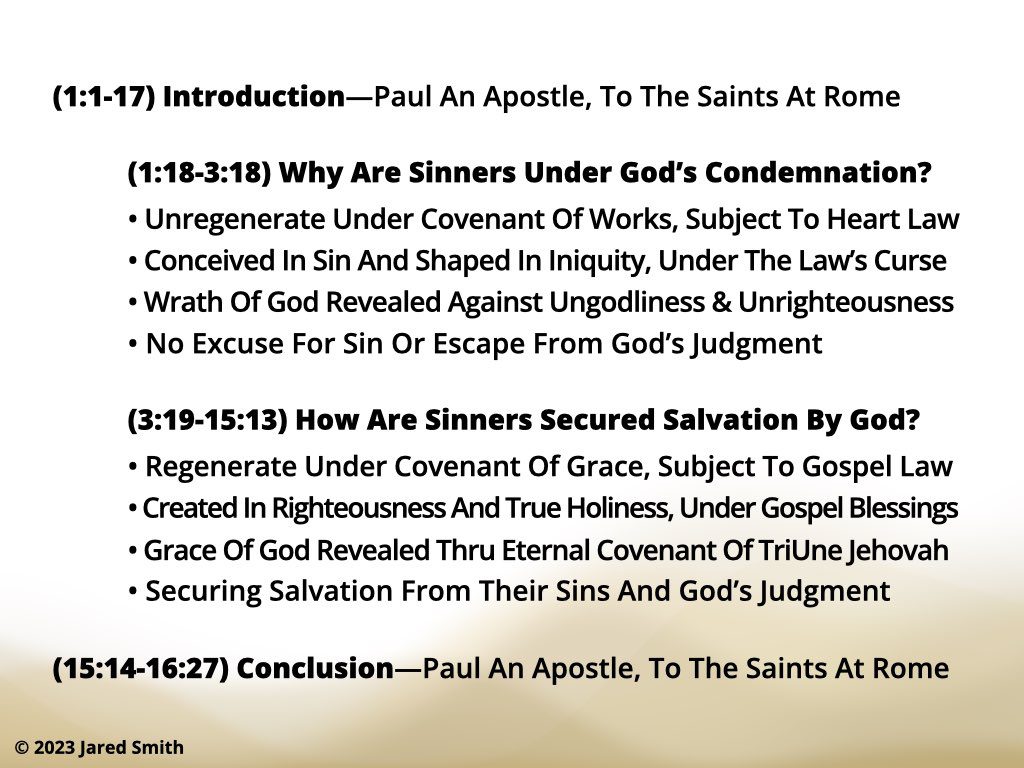
Sandwiched between an introduction (1:1-17) and a conclusion (15:14-16:27), there are two central questions the Apostle answers. First, why are sinners under the condemnation of God? This is answered in (1:18-3:18), with Paul explaining how the human race comes into the world under the authority of the covenant of works, and therefore made subject to the law inscribed upon their hearts, which was a blessing to Adam and Eve before the Fall, but is now a curse to all transgressors. He shows how the wrath of God is revealed from heaven against all ungodliness and unrighteousness of men, who stand guilty before God, without excuse for their sins and without escape from His judgment. The second question, how are sinners secured salvation by God? This is answered in (3:19-15:13), with Paul explaining how sinners are brought under the authority of the covenant of grace, and therefore made subject to the gospel law under which all spiritual blessings in heavenly places in Christ are given to them. He shows how the grace of God is revealed through the eternal covenant of the TriUne Jehovah, securing for His elect people salvation from their sins and His wrath. Now, the major branches of theology are comprehended under these two headings, which is why it is accurate to describe Paul’s letter to the Romans as a Body of Divinity—in my view, it is as close as it comes to a Systematic Theology contained in the scriptures. What John Calvin did for the Reformation in writing the Christian Institutes, and what John Gill did for the Particular Baptists in writing his Body of Divinity, Paul did for the scriptures in writing his letter to the Romans. And of course, Calvin’s Institutes and Gill’s Divinity are nothing other than expositions of Paul’s letter to the Romans. So, this is the main structure to the book of Romans.
However, in addition to the structure, I also presented a diagram which illustrates Paul’s teachings on the masterplan of God for the ages. I have called this diagram the Framework of Sovereign Grace.
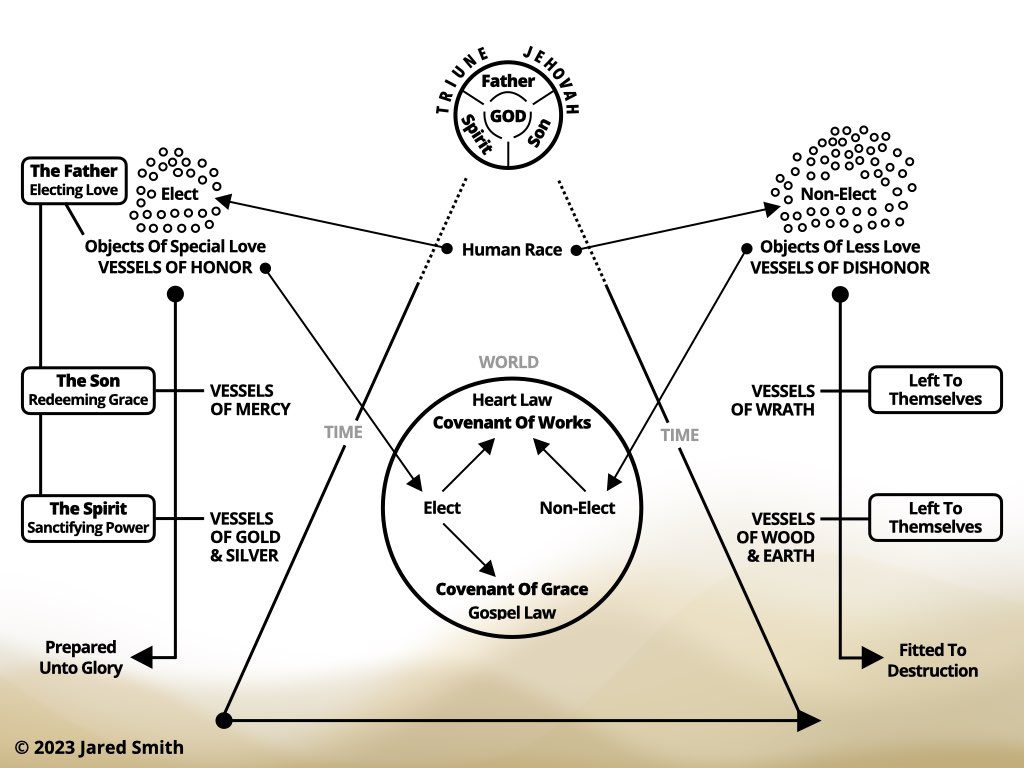
This overview of God’s masterplan is actually set forth by Paul himself in Romans 9. Therein he represents God as the Potter, envisioning the whole mass of the human race without sin, represented as a pure lump of clay, out from which the Father sets apart some people as objects of special love, making them vessels unto honor, while setting aside the others as objects of less love, making them vessels unto dishonor. This teaching has come to be known as the doctrine of Unconditional Election. The Father then determined to bring the human race into existence under the headship of Adam, with whom He would make a covenant of works, requiring of him perfect obedience to the heart law. In consequence of Adam’s transgression, the entire human race would be plunged into sin and misery. This teaching has come to be known as the doctrine of Total Depravity. The Father then determined to leave the non-elect in their sins, making them vessels of wrath and vessels of wood and earth, fitting them to destruction. This teaching has come to be known as the doctrine of Reprobation. However, as He already obligated Himself to the elect, setting His special love upon them, so He devised for them a plan of salvation. The first part of His plan was to give the elect to His Son, appointing Him to serve as their Mediator and Redeemer, making them vessels of mercy. In this way the Father would freely justify sinners through the redemption that is in Christ Jesus. This teaching has come to be known as the doctrine of Limited Atonement, or, Particular Redemption. The second part of His plan was to give the elect to the Spirit, appointing Him to serve as their Regenerator and Sanctifier, making them vessels of gold and silver. In this way the Father would freely regenerate sinners by uniting their souls to Christ, through the effectual power of the Holy Spirit. This teaching has come to be known as the doctrine of Irresistible Grace. This twofold plan of salvation is what we call the covenant of grace, or the covenant of redemption, wherein the TriUne Jehovah prepares His people unto glory. And this teaching has come to be known as the doctrine of the Perseverance and the Preservation of the Saints. All-in-all, this diagram sets forth what is commonly called the Doctrines of Grace, which is why I have labeled it the Framework of Sovereign Grace.
Now, the entire book of Romans is designed to explain in detail what I have just summarized for you according to this diagram. When Paul answers the question about sinners under God’s condemnation in (1:18-3:18), he is referring to the covenant of works God made with Adam on behalf of the human race. And when he answers the question about sinners under God’s grace in (3:19-15:13), he is referring to the covenant of grace the TriUne Jehovah made with Himself on behalf of the elect. It is for this reason I am using both the structure and the framework as the backdrop for my commentary styled exposition of Paul’s letter to the Romans. Everything I say about the book fits within the context of this structure and framework. So, that is what I covered in the first study of this series.
In the second study, I considered Paul’s introduction to the letter (1:1-17), wherein he not only identifies himself as a gospel preacher and apostle of the Lord Jesus Christ, but also the church in Rome to whom he sent the letter—they also, wrote Paul, are the called of Jesus Christ; they are beloved of God and called to be saints. Henceforth, the letter was addressed to and designed for believers in Christ, that they might be built up in the faith. It was not addressed to unbelievers or designed to be used as a tool for proselyting sinners, as so many misuse it today. For instance, you may be familiar with the proselyting tool of free will activists called the ‘Romans Road to Salvation’. They cherry pick five or six verses from the letter, formulating a do-it-yourself plan of salvation, telling unregenerate sinners the words of Paul are designed by God to lead them on the road to salvation. That, however, is not the design of Paul’s letter to the Romans. His purpose was to build up in their most holy faith those sinners who had already been regenerated by the Spirit of God. And you see, unless we approach the book with this design in mind, we will surely misinterpret its teachings and misrepresent the gospel message.
In the third study, I presented an overview of Paul’s answer to the question relating to the reason sinners are under the condemnation of God (1:18-3:18). This part of the letter may be divided into four more sections.
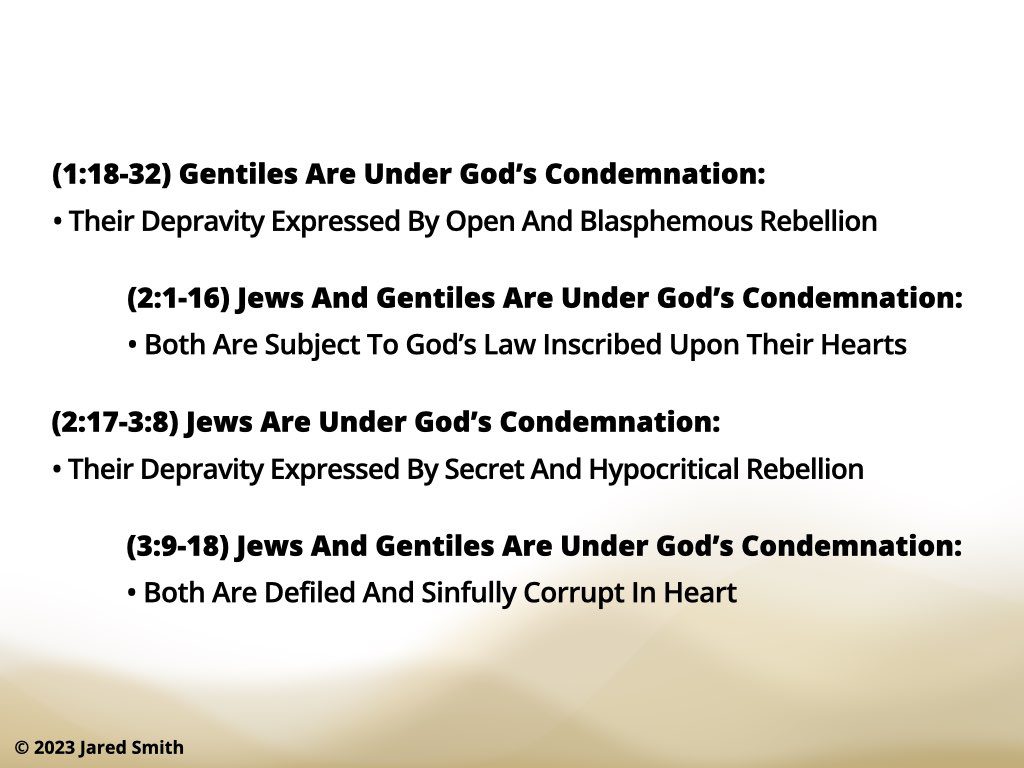
In (1:18-32), Paul singles out the Gentiles, explaining why they are under divine condemnation, exposing their open and blasphemous rebellion against God; In (2:1-16), he joins together the Jews and Gentiles, explaining how they are all subject to the Law God has inscribed upon their hearts; In (2:17-3:8), he singles out the Jews, explaining why they are under divine condemnation, exposing their secret and hypocritical rebellion against God; In (3:9-18), he joins together the Jews and Gentiles again, describing the sinful corruption of all their hearts. Thus, we have in these chapters an interplay between the Jews and the Gentiles, Paul distinguishing them on the one hand, but uniting them on the other.
In the fourth study, I explained Paul’s teachings in (1:18-32), where he describes the open and blasphemous rebellion of the Gentiles against the Lord, and why, therefore, they are under the just condemnation of God.
In the fifth study, I explained Paul’s teachings in (2:1-16), where he shows the significance of God’s law inscribed upon the heart, and why both Jews and Gentiles are under the condemnation of God as the result.
In the sixth study, I explained Paul’s teachings in (2:17-3:8), where he describes the secret and hypocritical rebellion of the Jews against the Lord, and why, therefore, they are also under the just condemnation of God.
In the seventh study, I explained Paul’s teachings in (3:9-18), where he gives a description of the human heart, conceived in sin and shaped in iniquity, which is true for both Jews and Gentiles, for there is no difference—all have sinned and come short of the glory of God. And it is here the Apostle finishes up his explanation as it relates particularly to the covenant of works and the unregenerate.
Now, it was appropriate at this point in the series to distinguish between three groups of people, which I did in the eighth study. First, there are the unregenerate, under the authority of the covenant of works and responsible to God according to the law inscribed upon their hearts. Second, there are the Jewish people as a nation, under the authority of the covenant of Moses and responsible to God according to the Mosaic law. Third, there are the regenerate, under the authority of the covenant of grace and responsible to God according to the gospel law, a living law, which is none other than the soul’s union with Christ. I emphasized the importance of distinguishing between these three groups for several reasons. First, because Paul mentions all three groups in his letter, and unless we understand what he means by each group, we will certainly misinterpret his writings which would lead to numerous false conclusions. Second, because Paul’s letter has already been misinterpreted and has indeed led to false conclusions. We therefore often come at Paul’s letter with preconceived ideas which act as obstacles to our understanding of it. Even among those belonging to my group—the High-Calvinists—there are some who speak of the Mosaic Covenant and its laws as if it has reference to people living today. They sometimes say, for instance, “Dear Christian, you are no longer under the law of Moses; you are no longer bound to the ten commandments; you are now under grace.” Well, actually, no one living today has ever been under the law of Moses, or subject to the ten commandments, because that Covenant and its laws were designed only for the Jewish people as a nation, and that nation existed for only around 1500 years, between 1450BC and 70AD. The same is true also of the Gentiles who lived during the time the Jewish nation existed—none of them were under the Mosaic covenant or subject to the ten commandments. So you see, when Paul speaks of the Mosaic covenant and its laws, he is addressing the Jewish people who were living during his day, and, I remind you, those Jews at that time still existed as a nation, and were therefore still under its authority and subject to its laws—the nation came to an end in 70AD, whereas Paul wrote his letter to the Romans around 58AD. It was therefore proper for the Apostle to tell the Jewish people in his day that they are no longer under the Mosaic covenant and its laws now that they had been converted to Christ, for Christ was the fulfillment of that covenant for them. But it makes no sense to speak this way to people living today, as if you and I are living under the yoke of the Mosaic covenant and its laws. Well, not only do some High-Calvinists make this mistake, but many other Christians belonging to the Arminian and Moderate-Calvinist groups err in this regard. Their fault lies in mismatching the duties and privileges God has placed under the covenant of works and the covenant of grace. They say, the unregenerate sinners are responsible to savingly believe on Christ (duty faith), though they are under the authority of the covenant of works, whereas regenerate sinners are responsible to perfectly obey the heart law, or worst, the ten commands as a life code, (progressive sanctification) though they be under the authority of the covenant of grace. Now, you see, this is all backwards. The unregenerate are responsible to keep the heart law since they are under the authority of the covenant of works, whereas the regenerate are responsible to savingly believe on Christ since they are under the authority of the covenant of grace. This is the proper order of things, and I believe it is key to understanding Paul’s teachings when it comes to these distinguished groups. Well, that’s what I dealt with in the eighth study.
In the ninth study, I began to unfold Paul’s teachings on the second main section of the letter—how sinners are secured salvation by God. This is by far the longest part of the letter, extending from chapters three to fifteen (3:19-15:13). In these chapters, Paul explains the terms and promises of the covenant of grace, dealing in detail with the role assumed by the Father, the Son and the Holy Spirit in the work of the sinner’s salvation.
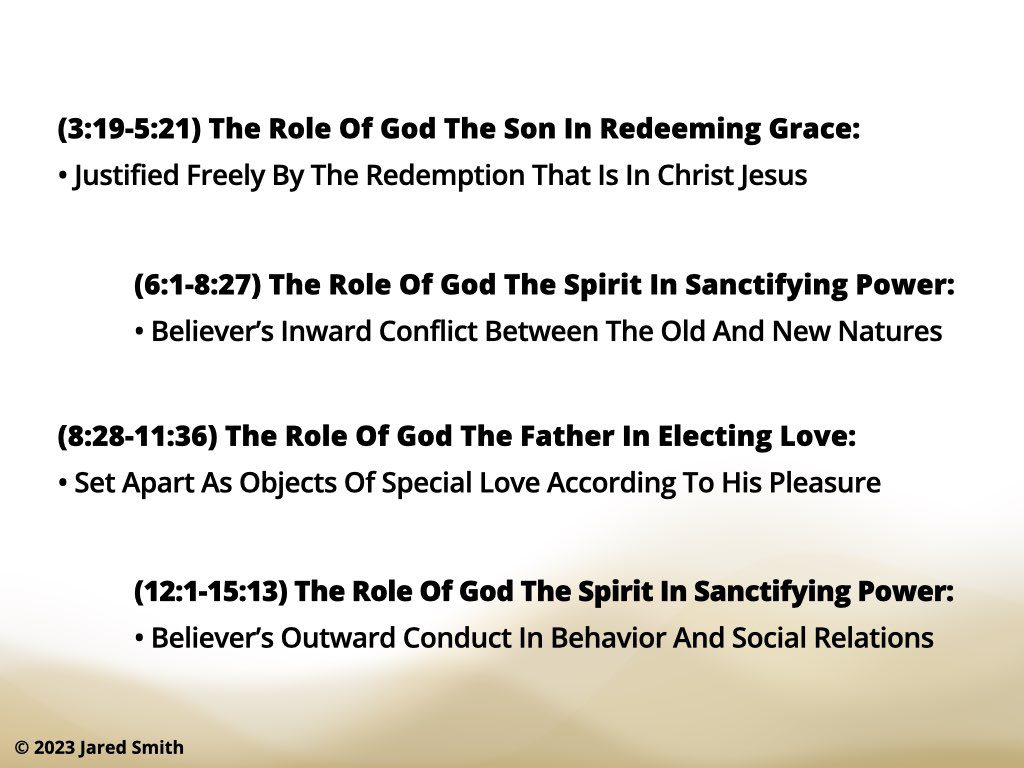
He begins in (3:19-5:21) with the role of the Son, in the person of the Lord Jesus Christ, showing how the sinner is freely justified by the redemption that is in Christ Jesus. He shows how a particular atonement is made for God’s elect people, procuring their salvation by the shedding of Christ’s precious blood. He then turns to the role of the Holy Spirit in (6:1-8:27), explaining how sinners are sanctified by His personal indwelling. He makes specific reference to the believer’s inward conflict between the old and new natures, providing a number of instructions to help the believer live out his/her life in Christ. He then turns to the role of the Father in (8:28-11:36), explaining how the sinner has been set apart as an object of God’s special love from eternity. He shows how the number of God’s elect people only make up a remnant of the human race, but that He has chosen a people out of every nation and kindred. Indeed, Paul demonstrates how the electing love of God the Father is the basis for the redeeming grace of God the Son as well as for the sanctifying power of God the Spirit. Paul then returns to the role of the Holy Spirit in (12:1-15:13), once more explaining how sinners are sanctified by His personal indwelling. Only this time, he makes specific reference to the believer’s outward conduct, providing many helpful instructions encouraging the believer show forth the praises of God who has called him out of darkness into His marvelous light. Now, it was my joy in the last study to begin looking at Paul’s teachings regarding the Son’s role in the work of our salvation (3:19-5:21), all of which deals with the doctrine of Justification—the free justification by God the Father through the redemption that is in Christ Jesus. This section of the letter may be divided under four more headings:
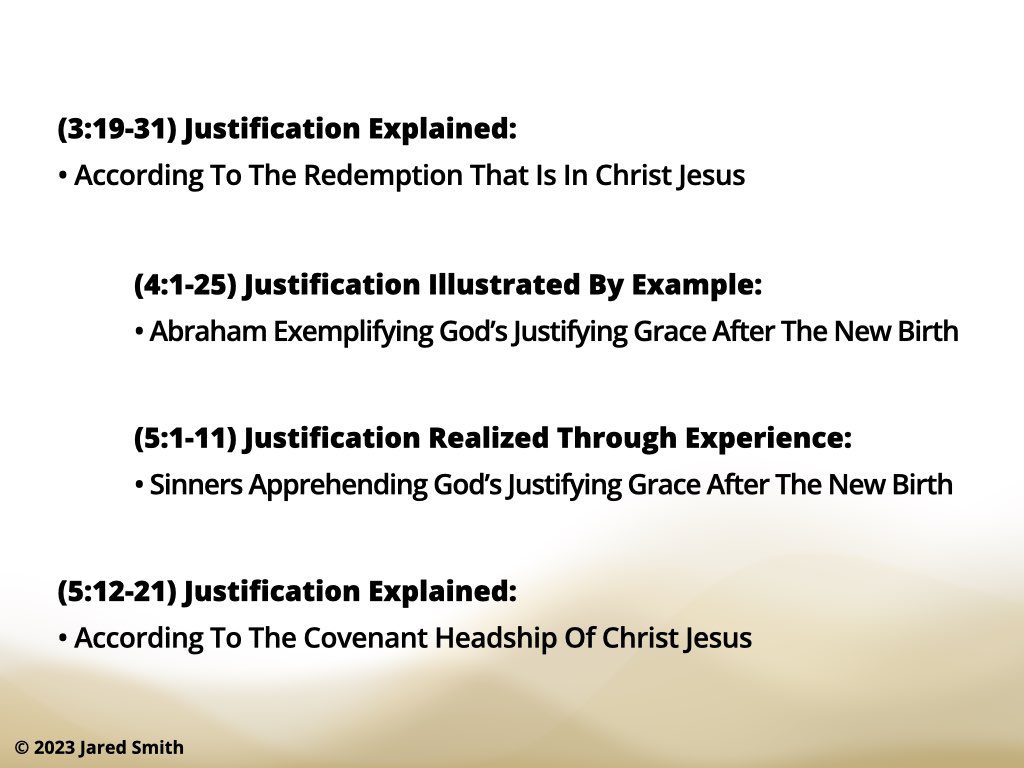
In (3:19-31), Paul explains the meaning of justification, as it relates to the redeeming work of the Lord Jesus Christ. In (4:1-25), he gives an example of Abraham who had been freely justified by Christ’s redemption. In (5:1-11), he describes the experience of sinners who are brought to a realization of their justification. In (5:12-21), he returns to an explanation of justification, as it relates to the covenant headship of the Lord Jesus Christ. As you can see, the sinner’s justification is handled by Paul with great care, and it was the first part of his teachings I looked at in the previous study—his explanation on what the term justification means, with particular reference to the redeeming grace of the Lord Jesus Christ.
For our next study, before looking at the example of Abraham as one who had been freely justified by God (4:1-25), I would like to insert two further studies on the meaning of Justification, exploring how the term is used throughout the Word of God. I will divide these studies between those scriptures which speak of self-justification and the others which refer to God-justification. I wonder if you have considered the difference between these types of justification? Well, perhaps you can give it some thought in preparation for the next time we meet. Until then, I hope you will take the time to read again Paul’s letter to the Romans, praying the notes I have given will prove beneficial to your journey through the Word of God. Until we meet again for the next study, may the Lord bless you!
Jared Smith served twenty years as pastor of a Strict and Particular Baptist church in Kensington (London, England). He now serves as an Evangelist in the Philippines, preaching the gospel, organizing churches and training gospel preachers.
Jared Smith on Eldership
Jared Smith on the Biblical Covenants
Jared Smith on the Gospel Law
Jared Smith on the Gospel Message
Jared Smith on Various Issues
Jared Smith, Covenant Baptist Church, Philippines
Jared Smith on Bible Doctrine
Jared Smith on Bible Reading
Jared Smith's Studies in Romans
Jared Smith's Hymn Studies
Jared Smith's Maternal Ancestry (Complete)
Jared Smith's Sermons




